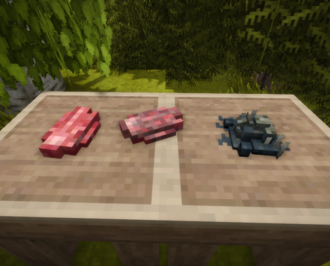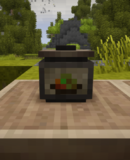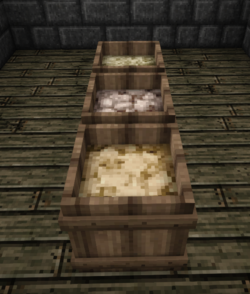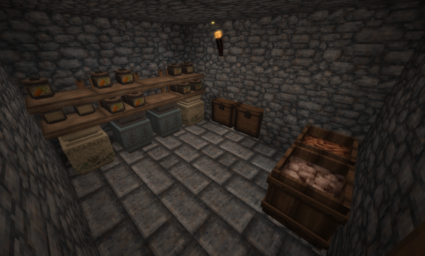Food preservation: Difference between revisions
m (Linking to the new generic Room page with more and updated information.) |
|||
| (82 intermediate revisions by 19 users not shown) | |||
| Line 1: | Line 1: | ||
{{GameVersion|1.15.10}} | |||
<languages/><translate> | |||
<!--T:50--> | |||
[[File:soiling_example.png|330px|thumb|right|Example of a piece of redmeat spoiling. From left to right, 100% freshness, 50% spoiled, 100% spoiled (rot)]] | |||
<!--T:170--> | |||
Most foods have a perish time, meaning they will spoil over time, losing nutritional value, and eventually turn into rot. To combat this, there are certain '''preservation methods''' to keep your food supply fresh, like special storage containers and cellars. | |||
<!--T:71--> | |||
[[File:Cleaning_cooking_pot.gif|130px|thumb|float|Cooking pot being cleaned.]] | |||
<!--T:51--> | |||
{{ll|Rot|Rotten food}} inside a container such as a bowl, crock or pot can be removed by dropping it into water. After a few seconds, the rot will float to the surface and separate from the container. Sealed crocks with rotten food need to be first unsealed, by getting one food portion with a bowl. | |||
</translate> | |||
__TOC__ | |||
<translate> | |||
==Shelf Life== <!--T:52--> | |||
<!--T:76--> | |||
Every kind of object has a different "perish time" which is composed of their “freshness time”, which is the time it takes for a fresh item to start spoiling; and their “spoilage time”, which is the time it takes for the item to turn into rot. | |||
</translate> | |||
{| class="wikitable mw-collapsible mw-collapsed" style="background: transparent; width: 34%;" | |||
|- | |||
! colspan=5 | <translate><!--T:77--> Meat</translate> | |||
|- | |||
* '' | ! width="1%"; rowspan=2 | <translate><!--T:78--> Image</translate> | ||
! width="3%"; rowspan=2 | <translate><!--T:79--> Item</translate> | |||
! width="3%"; colspan=2 | <translate><!--T:80--> Perish Time</translate> | |||
! width="3%"; rowspan=2 | <translate><!--T:81--> Rot produced after spoiling</translate> | |||
|- | |||
! <translate><!--T:82--> Freshness Time (hours)</translate> | |||
! <translate><!--T:83--> Spoilage Time (hours)</translate> | |||
|- | |||
| style="text-align:center" | [[File:Raw_meats.gif|40px]] | |||
| '''<translate><!--T:84--> Raw Meats</translate>*''' | |||
| style="text-align:center" | 36 | |||
| style="text-align:center" | 24 | |||
| style="text-align:center" | 1 | |||
|- | |||
| style="text-align:center" | [[File:Cooked_meats.gif|40px]] | |||
| '''<translate><!--T:85--> Cooked Meats</translate>*''' | |||
| style="text-align:center" | 120 | |||
| style="text-align:center" | 36 | |||
| style="text-align:center" | 1 | |||
|- | |||
| style="text-align:center" | [[File:Cured_meats.gif|40px]] | |||
| '''<translate><!--T:86--> Cured Meats</translate>*''' | |||
| style="text-align:center" | 8760 | |||
| style="text-align:center" | 4380 | |||
| style="text-align:center" | 1 | |||
|- | |||
| style="text-align:center" | [[File:Insect_items.gif|40px]] | |||
| '''<translate><!--T:87--> Termites</translate>''' | |||
| style="text-align:center" | 48 | |||
| style="text-align:center" | 18 | |||
| style="text-align:center" | 0.5 | |||
|- | |||
| style="text-align:center" | [[File:Egg_chicken_raw.png|40px]] | |||
| '''<translate><!--T:88--> Egg</translate>''' | |||
| style="text-align:center" | 120 | |||
| style="text-align:center" | 24 | |||
| style="text-align:center" | 0.5 | |||
|- | |||
| style="text-align:left"; colspan=5 | *<translate><!--T:89--> '''Meats''' meaning bushmeat, redmeat, and poultry</translate> | |||
|} | |||
{| class="wikitable mw-collapsible mw-collapsed" style="background: transparent; width: 34%;" | |||
|- | |||
! colspan=5 | <translate><!--T:90--> Fruits</translate> | |||
|- | |||
! width="1%"; rowspan=2 | <translate><!--T:91--> Image</translate> | |||
! width="3%"; rowspan=2 | <translate><!--T:92--> Item</translate> | |||
! width="3%"; colspan=2 | <translate><!--T:93--> Perish Time</translate> | |||
! width="3%"; rowspan=2 | <translate><!--T:94--> Rot produced after spoiling</translate> | |||
|- | |||
! <translate><!--T:95--> Freshness Time (hours)</translate> | |||
! <translate><!--T:96--> Spoilage Time (hours)</translate> | |||
|- | |||
| style="text-align:center" | [[File:fruit-cranberry.png|40px]] | |||
| '''<translate><!--T:97--> Cranberry</translate>''' | |||
| style="text-align:center" | 96 | |||
| style="text-align:center" | 12 | |||
| style="text-align:center" | 0.25 | |||
|- | |||
| style="text-align:center" | [[File:All_currants_blueberry.gif|40px]] | |||
| '''<translate><!--T:98--> Other Berries</translate>*''' | |||
| style="text-align:center" | 48 | |||
| style="text-align:center" | 12 | |||
| style="text-align:center" | 0.25 | |||
|- | |||
| style="text-align:center" | [[File:pineapple.png|40px]] | |||
| '''<translate><!--T:99--> Pineapple</translate>''' | |||
| style="text-align:center" | 156 | |||
| style="text-align:center" | 48 | |||
| style="text-align:center" | 2 | |||
|- | |||
| style="text-align:center" | [[File:fruit_pineapple.png|40px]] | |||
| '''<translate><!--T:100--> Pineapple Slices</translate>''' | |||
| style="text-align:center" | 48 | |||
| style="text-align:center" | 12 | |||
| style="text-align:center" | 0.25 | |||
|- | |||
| style="text-align:center" | [[File:fruit-saguaro.png|40px]] | |||
| '''<translate><!--T:101--> Saguaro Fuit</translate>''' | |||
| style="text-align:center" | 48 | |||
| style="text-align:center" | 12 | |||
| style="text-align:center" | 0.25 | |||
|- | |||
| style="text-align:left"; colspan=5 | *<translate><!--T:102--> '''Other berries''' meaning blueberry, white currant, red currant, and black currant</translate> | |||
|} | |||
==== | {| class="wikitable mw-collapsible mw-collapsed" style="background: transparent; width: 34%;" | ||
* | |- | ||
! colspan=5 | <translate><!--T:103--> Vegetables</translate> | |||
|- | |||
! width="1%"; rowspan=2 | <translate><!--T:104--> Image</translate> | |||
==== | ! width="3%"; rowspan=2 | <translate><!--T:105--> Item</translate> | ||
! width="3%"; colspan=2 | <translate><!--T:106--> Perish Time</translate> | |||
! width="3%"; rowspan=2 | <translate><!--T:107--> Rot produced after spoiling</translate> | |||
|- | |||
! <translate><!--T:108--> Freshness Time (hours)</translate> | |||
! <translate><!--T:109--> Spoilage Time (hours)</translate> | |||
|- | |||
| style="text-align:center" | [[File:All_mushrooms.gif|40px]] | |||
| '''<translate><!--T:110--> Mushrooms</translate>''' | |||
| style="text-align:center" | 432 | |||
| style="text-align:center" | 72 | |||
| style="text-align:center" | 1 | |||
|- | |||
| style="text-align:center" | [[File:Papyrus_cattail_roots.gif|40px]] | |||
| '''<translate><!--T:111--> Cooked Roots</translate>''' | |||
| style="text-align:center" | 48 | |||
| style="text-align:center" | 18 | |||
| style="text-align:center" | 0.5 | |||
|- | |||
| style="text-align:center" | [[File:Legumes.gif|40px]] | |||
| '''<translate><!--T:112--> Legumes</translate>*''' | |||
| style="text-align:center" | 8760 | |||
| style="text-align:center" | 876 | |||
| style="text-align:center" | 0.5 | |||
|- | |||
| style="text-align:center" | [[File:Vegetable_onion.png|40px]] | |||
| '''<translate><!--T:113--> Onion</translate>''' | |||
| style="text-align:center" | 672 | |||
| style="text-align:center" | 120 | |||
| style="text-align:center" | 0.5 | |||
|- | |||
| style="text-align:center" | [[File:Pumpkin-fruit-4.png|40px]] | |||
| '''<translate><!--T:114--> Pumpkin</translate>''' | |||
| style="text-align:center" | 672 | |||
| style="text-align:center" | 120 | |||
| style="text-align:center" | 2 | |||
|- | |||
| style="text-align:center" | [[File:Pumpkin_slices.png|40px]] | |||
| '''<translate><!--T:115--> Pumpkin Slices</translate>''' | |||
| style="text-align:center" | 432 | |||
| style="text-align:center" | 144 | |||
| style="text-align:center" | 0.55 | |||
|- | |||
| style="text-align:center" | [[File:Raw_cassava.png|40px]] | |||
| '''<translate><!--T:116--> Raw Cassava</translate>''' | |||
| style="text-align:center" | 672 | |||
| style="text-align:center" | 120 | |||
| style="text-align:center" | 0.5 | |||
|- | |||
| style="text-align:center" | [[File:Dried_cassava.png|40px]] | |||
| '''<translate><!--T:117--> Dried Cassava</translate>''' | |||
| style="text-align:center" | 2688 | |||
| style="text-align:center" | 120 | |||
| style="text-align:center" | 0.5 | |||
|- | |||
| style="text-align:center" | [[File:bellpepper.png|40px]] | |||
| '''<translate><!--T:118--> Bell Pepper</translate>''' | |||
| style="text-align:center" | 288 | |||
| style="text-align:center" | 72 | |||
| style="text-align:center" | 0.5 | |||
|- | |||
| style="text-align:center" | [[File:Other_vegetables.gif|40px]] | |||
| '''<translate><!--T:119--> Other Vegetables</translate>*''' | |||
| style="text-align:center" | 504 | |||
| style="text-align:center" | 96 | |||
| style="text-align:center" | 0.5 | |||
|- | |||
| style="text-align:center" | [[File:pickled_soybean.png|40px]] | |||
| '''<translate><!--T:120--> Pickled Soybean</translate>''' | |||
| style="text-align:center" | 4320 | |||
| style="text-align:center" | 1432 | |||
| style="text-align:center" | 0.5 | |||
|- | |||
| style="text-align:center" | [[File:All_pickled_vegetables.gif|40px]] | |||
| '''<translate><!--T:121--> Other Pickled Vegetables</translate>*''' | |||
| style="text-align:center" | 1800 | |||
| style="text-align:center" | 240 | |||
| style="text-align:center" | 0.5 | |||
|- | |||
| style="text-align:left"; colspan=5 | *<translate><!--T:122--> '''Legumes''' meaning peanuts and soybeans.</translate> <br/ > *<translate><!--T:169--> '''Other vegetables''' meaning carrot, parsnip, turnip, and cabbage.</translate> <br/ > *<translate><!--T:123--> '''Other pickled vegetables''' meaning pickled bellpepper, pickled parsnip, pickled turnip, pickled onion, pickled pumpkin, and pickled cabbage.</translate> | |||
|} | |||
=== | {| class="wikitable mw-collapsible mw-collapsed" style="background: transparent; width: 34%;" | ||
|- | |||
! colspan=5 | <translate><!--T:124--> Grain</translate> | |||
|- | |||
==== | ! width="1%"; rowspan=2 | <translate><!--T:125--> Image</translate> | ||
! width="3%"; rowspan=2 | <translate><!--T:126--> Item</translate> | |||
! width="3%"; colspan=2 | <translate><!--T:127--> Perish Time</translate> | |||
! width="3%"; rowspan=2 | <translate><!--T:128--> Rot produced after spoiling</translate> | |||
|- | |||
! <translate><!--T:129--> Freshness Time (hours)</translate> | |||
! <translate><!--T:130--> Spoilage Time (hours)</translate> | |||
|- | |||
| style="text-align:center" | [[File:All_grains.gif|40px]] | |||
| '''<translate><!--T:131--> Grain</translate>''' | |||
| style="text-align:center" | 2160 | |||
| style="text-align:center" | 244 | |||
| style="text-align:center" | 0.25 | |||
|- | |||
| style="text-align:center" | [[File:All_flours.gif|40px]] | |||
| '''<translate><!--T:132--> Flour</translate>''' | |||
| style="text-align:center" | 4320 | |||
| style="text-align:center" | 336 | |||
| style="text-align:center" | 0.25 | |||
|- | |||
| style="text-align:center" | [[File:All_doughs.gif|40px]] | |||
| '''<translate><!--T:133--> Dough</translate>''' | |||
| style="text-align:center" | 48 | |||
| style="text-align:center" | 24 | |||
| style="text-align:center" | 1 | |||
|- | |||
| style="text-align:center" | [[File:All_breads.gif|40px]] | |||
| '''<translate><!--T:134--> Bread</translate>''' | |||
| style="text-align:center" | 192 | |||
| style="text-align:center" | 36 | |||
| style="text-align:center" | 1 | |||
|- | |||
| style="text-align:center" | [[File:All_bread_partbaked.gif|40px]] | |||
| '''<translate><!--T:135--> Part-Baked Bread</translate>''' | |||
| style="text-align:center" | 120 | |||
| style="text-align:center" | 24 | |||
| style="text-align:center" | 1 | |||
|- | |||
| style="text-align:center" | [[File:All_breads_charred.gif|40px]] | |||
| '''<translate><!--T:136--> Charred Bread</translate>''' | |||
| style="text-align:center" | 420 | |||
| style="text-align:center" | 60 | |||
| style="text-align:center" | 1 | |||
|} | |||
==== | {| class="wikitable mw-collapsible mw-collapsed" style="background: transparent; width: 34%;" | ||
|- | |||
! colspan=5 | <translate><!--T:137--> Dairy</translate> | |||
|- | |||
! width="1%"; rowspan=2 | <translate><!--T:138--> Image</translate> | |||
! width="3%"; rowspan=2 | <translate><!--T:139--> Item</translate> | |||
! width="3%"; colspan=2 | <translate><!--T:140--> Perish Time</translate> | |||
! width="3%"; rowspan=2 | <translate><!--T:141--> Rot produced after spoiling</translate> | |||
|- | |||
! <translate><!--T:142--> Freshness Time (hours)</translate> | |||
! <translate><!--T:143--> Spoilage Time (hours)</translate> | |||
|- | |||
| style="text-align:center" | [[File:Milkportion.png|40px]] | |||
| '''<translate><!--T:144--> Milk Portion</translate>''' | |||
| style="text-align:center" | 96 | |||
| style="text-align:center" | 96 | |||
| style="text-align:center" | 0.1 | |||
|- | |||
| style="text-align:center" | [[File:Cottagecheeseportion.png|40px]] | |||
| '''<translate><!--T:145--> Cottage Cheese Portion</translate>''' | |||
| style="text-align:center" | 240 | |||
| style="text-align:center" | 96 | |||
| style="text-align:center" | 0.1 | |||
|- | |||
| style="text-align:center" | [[File:Cheddar_cheese.png|40px]] | |||
| '''<translate><!--T:146--> Cheddar Cheese</translate>''' | |||
| style="text-align:center" | 4320 | |||
| style="text-align:center" | 12 | |||
| style="text-align:center" | 1 <translate><!--T:171--> per slice</translate> | |||
|- | |||
| style="text-align:center" | [[File:Waxed_cheddar_cheese.png|40px]] | |||
| '''<translate><!--T:147--> Waxed Cheddar Cheese</translate>''' | |||
| style="text-align:center" | 8640 | |||
| style="text-align:center" | 12 | |||
| style="text-align:center" | 1 <translate><!--T:172--> per slice</translate> | |||
|- | |||
| style="text-align:center" | [[File:Blue_cheese.png|40px]] | |||
| '''<translate><!--T:148--> Blue Cheese</translate>''' | |||
| style="text-align:center" | 5400 | |||
| style="text-align:center" | 12 | |||
| style="text-align:center" | 1 <translate><!--T:173--> per slice</translate> | |||
|} | |||
<translate> | |||
<!--T:149--> | |||
When combining stacks of food items, their average overall perish time will become the new perish time for both items. | |||
== | ===Cooked Meals=== <!--T:72--> | ||
<!--T:150--> | |||
For cooked items, their new shelf life depends on the freshness of the ingredients. Fresher ingredients mean much longer preservation time. If you cook with a partially spoiled ingredient the new meal will start spoiled. | |||
=== | == Factors affecting food spoilage == <!--T:58--> | ||
<!--T:151--> | |||
The perish time of a food item can be longer or shorter depending on a variety of circumstances: | |||
=== Climate === <!--T:59--> | |||
<!--T:152--> | |||
The climate in which the food is stored affects the rate of food spoilage. Hot climates can increase the decay rate up to 2.5x (250%), while very cold climates can reduce the decay rate down to 0.1x (10%). Only the climate at sea level is considered, so placing your food high up in the mountains will have no effect if the mountain is in a hot climate.<br> | |||
You can however completely negate the impact of climate by building a cellar. | |||
=== Food type === <!--T:60--> | |||
<!--T:153--> | |||
Different types of foods have different lifetimes. As mentioned before, food items remain 100% fresh for a specific time period (shown in the tables above). After this time, food items begin to decay at a rate affected by storage containers, storage locations, and climate conditions. As food items decay, they lose {{ll|nutrition|nutrition}} value and will eventually become "rot". The food items with the highest perish time from each category are: Cured meat (meats), Pineapple (fruits), Soybean/Peanuts (vegetables), Flour (grain), and Waxed Cheddar Cheese (dairy). | |||
== Food preservation containers == <!--T:61--> | |||
<!--T:154--> | |||
[[File:crock_example.png|130px|thumb|right|Crock with cabbage stew.]] | |||
<!--T:155--> | |||
While food can be stored in any stationary container, {{ll|storage vessels|storage vessels}} are best for storing grains and vegetables. Storage vessels and crocks are fairly easy to make, requiring only {{ll|Clay Forming|clay}}. However to increase the shelf life of meats and vegetables, combining preserving methods with containers is best. | |||
== | === Crocks === <!--T:156--> | ||
<!--T:157--> | |||
Can hold up to 4 portions of meals or pickled vegetables can be stored in crocks providing a slight reduction in food decay, which is a good option for short term food storage. For long term storage, sealing the crocks with a lump of fat or beeswax above the crock in the crafting grid reduces decay by a factor of 10. Filled crocks may be carried in player inventories. For convenience you can build shelves that can hold up to 8 crocks at a time. | |||
<!--T: | === Storage Vessels === <!--T:62--> | ||
<!--T:158--> | |||
Any food item can be stored in vessels, which provide storage benefits to preserved foods as well as raw foods. These vessels are good options for short and long term food storage as they reduce decay 75% for veggies and 50% for grains. | |||
== | == Food preservation processes == <!--T:63--> | ||
<!--T: | <!--T:159--> | ||
Food preservation | [[File:barrel_pickled_example.png|250px|thumb|right|Barrels full of pickled food.]] | ||
' | |||
<!--T:160--> | |||
Almost all types of food items can be stored in the form of cooked meals, but it’s not always practical to do so. For this, there’s special food processing methods that increase their lifespan significantly. Due to the different components in foods, there are various processes to preserve each type or category of food. | |||
=== Jam === <!--T:73--> | |||
<!--T:161--> | |||
Making jam requires a cooking pot, a bucket, honey, and berries. By using a cooking pot, add a minimum of two berries and two units of honey to make jam. For the longest shelf life, jam should be stored in a sealed crock. | |||
=== Salt curing === <!--T:64--> | |||
<!--T:162--> | |||
Curing meats requires a barrel, salt and the raw meat to preserve. Each unit of meat requires two units of salt, i.e. 32 meat = 64 salt. After adding the appropriate ingredients into the input slot of the barrel, the GUI will state the process yield. At this point the barrel must be sealed for 480 hours to complete the curing process. | |||
=== Pickling === <!--T:65--> | |||
<!--T:163--> | |||
Pickling vegetables requires a barrel, a bucket, salt, water, and the vegetables to preserve. Water and salt are mixed in the barrel to make brine before adding the vegetables. Otherwise, the process of pickling is very similar to salt curing. Each vegetable or legume uses one unit of brine and the barrel must remain sealed for 336 hours. Once the food items are pickled or salt preserved, they can be stored in any stationary container, though storage vessels are best. | |||
=== Cheese === <!--T:66--> | |||
<!--T:164--> | |||
Milk can be turned into {{ll|cheese|cheese}} by processing it in several steps with pickled vegetables and salt in a barrel. See the {{ll|Cheese|cheesemaking}} section for more details. | |||
== Food preservation locations == <!--T:67--> | |||
<!--T:165--> | |||
:''See also {{ll|Room#Cellar|Cellar}}.'' | |||
<!--T:166--> | |||
[[File:Cellar.png|425px|thumb|right|Typical layout of a cellar filled with crocks on shelves, storage vessels, chests and 2 barrels of pickled food.]] | |||
<!--T:167--> | |||
To negate the impact of a warm climate, build a cellar. Cellars have a fixed temperature of 5°C or colder if the ambient temperature is lower, meaning you will only profit from a cellar if the outside temperature is higher than 8°C in the first place. | |||
=== Recommendations === <!--T:74--> | |||
<!--T:168--> | |||
* Build the walls from soil, ceramic, or stone materials and keep door/trapdoor count low. It’s best to not use any doors/trapdoors, and instead use dirt or hay as full-block fillers. The less light inviting openings the cellar has, the better - additionally, doors do not count as a soil or stone block and thus lower the efficiency, even if they do not let in sunlight. | |||
* Keep the sun light level inside the cellar low, as it can raise the temperature by up to 10°C, thus influencing spoilage rate. Artificial lights like lanterns, torches and oil lamps are fine. This means building a cellar underground can help reduce the entry of sunlight, but it doesn't give a bonus solely on the fact it’s underground. Cellars can be located above ground, as long as they are safe from the sun. | |||
* Cellars should be no larger than 7x7x7 blocks inside. If the room exceeds these dimensions, it will not be recognized as a cellar. Only the direct walls count, the corner rows can be left out without affecting the room recognition. | |||
* Once a cellar is created any food items may be placed on a shelf or inside containers. A typical cellar layout is filled with crocks on shelves, storage vessels, chests and barrels of pickled food. All items stored in the cellar will receive equal food decay reduction. | |||
* Unlike other room types, cellars react sensitively to chiselled blocks, even if the full block face points inwards. In some cases, the game may be unable to correctly calculate a chiselled block and therefore let light get in through there. It is recommended to either use no chiselled blocks in the cellar at all, or to make sure that there is an additional, complete-block layer covering these chiselled blocks. | |||
<!--T:68--> | |||
{{Protip | |||
|Players can verify the storage benefit by looking at the block info HUD of a shelf or storage container. It will display something like Stored food perish speed: 0.25 in this case meaning food will last 4 times longer. | |||
}} | |||
</translate> | |||
{{Game navbox}} | |||
[[Category:Food{{#translation:}}]] | |||
[[Category:Guides{{#translation:}}]] | |||
Latest revision as of 03:56, 27 March 2024
This page was last verified for Vintage Story version 1.15.10.
Most foods have a perish time, meaning they will spoil over time, losing nutritional value, and eventually turn into rot. To combat this, there are certain preservation methods to keep your food supply fresh, like special storage containers and cellars.
Rotten food inside a container such as a bowl, crock or pot can be removed by dropping it into water. After a few seconds, the rot will float to the surface and separate from the container. Sealed crocks with rotten food need to be first unsealed, by getting one food portion with a bowl.
Shelf Life
Every kind of object has a different "perish time" which is composed of their “freshness time”, which is the time it takes for a fresh item to start spoiling; and their “spoilage time”, which is the time it takes for the item to turn into rot.
When combining stacks of food items, their average overall perish time will become the new perish time for both items.
Cooked Meals
For cooked items, their new shelf life depends on the freshness of the ingredients. Fresher ingredients mean much longer preservation time. If you cook with a partially spoiled ingredient the new meal will start spoiled.
Factors affecting food spoilage
The perish time of a food item can be longer or shorter depending on a variety of circumstances:
Climate
The climate in which the food is stored affects the rate of food spoilage. Hot climates can increase the decay rate up to 2.5x (250%), while very cold climates can reduce the decay rate down to 0.1x (10%). Only the climate at sea level is considered, so placing your food high up in the mountains will have no effect if the mountain is in a hot climate.
You can however completely negate the impact of climate by building a cellar.
Food type
Different types of foods have different lifetimes. As mentioned before, food items remain 100% fresh for a specific time period (shown in the tables above). After this time, food items begin to decay at a rate affected by storage containers, storage locations, and climate conditions. As food items decay, they lose nutrition value and will eventually become "rot". The food items with the highest perish time from each category are: Cured meat (meats), Pineapple (fruits), Soybean/Peanuts (vegetables), Flour (grain), and Waxed Cheddar Cheese (dairy).
Food preservation containers
While food can be stored in any stationary container, storage vessels are best for storing grains and vegetables. Storage vessels and crocks are fairly easy to make, requiring only clay. However to increase the shelf life of meats and vegetables, combining preserving methods with containers is best.
Crocks
Can hold up to 4 portions of meals or pickled vegetables can be stored in crocks providing a slight reduction in food decay, which is a good option for short term food storage. For long term storage, sealing the crocks with a lump of fat or beeswax above the crock in the crafting grid reduces decay by a factor of 10. Filled crocks may be carried in player inventories. For convenience you can build shelves that can hold up to 8 crocks at a time.
Storage Vessels
Any food item can be stored in vessels, which provide storage benefits to preserved foods as well as raw foods. These vessels are good options for short and long term food storage as they reduce decay 75% for veggies and 50% for grains.
Food preservation processes
Almost all types of food items can be stored in the form of cooked meals, but it’s not always practical to do so. For this, there’s special food processing methods that increase their lifespan significantly. Due to the different components in foods, there are various processes to preserve each type or category of food.
Jam
Making jam requires a cooking pot, a bucket, honey, and berries. By using a cooking pot, add a minimum of two berries and two units of honey to make jam. For the longest shelf life, jam should be stored in a sealed crock.
Salt curing
Curing meats requires a barrel, salt and the raw meat to preserve. Each unit of meat requires two units of salt, i.e. 32 meat = 64 salt. After adding the appropriate ingredients into the input slot of the barrel, the GUI will state the process yield. At this point the barrel must be sealed for 480 hours to complete the curing process.
Pickling
Pickling vegetables requires a barrel, a bucket, salt, water, and the vegetables to preserve. Water and salt are mixed in the barrel to make brine before adding the vegetables. Otherwise, the process of pickling is very similar to salt curing. Each vegetable or legume uses one unit of brine and the barrel must remain sealed for 336 hours. Once the food items are pickled or salt preserved, they can be stored in any stationary container, though storage vessels are best.
Cheese
Milk can be turned into cheese by processing it in several steps with pickled vegetables and salt in a barrel. See the cheesemaking section for more details.
Food preservation locations
- See also Cellar.
To negate the impact of a warm climate, build a cellar. Cellars have a fixed temperature of 5°C or colder if the ambient temperature is lower, meaning you will only profit from a cellar if the outside temperature is higher than 8°C in the first place.
Recommendations
- Build the walls from soil, ceramic, or stone materials and keep door/trapdoor count low. It’s best to not use any doors/trapdoors, and instead use dirt or hay as full-block fillers. The less light inviting openings the cellar has, the better - additionally, doors do not count as a soil or stone block and thus lower the efficiency, even if they do not let in sunlight.
- Keep the sun light level inside the cellar low, as it can raise the temperature by up to 10°C, thus influencing spoilage rate. Artificial lights like lanterns, torches and oil lamps are fine. This means building a cellar underground can help reduce the entry of sunlight, but it doesn't give a bonus solely on the fact it’s underground. Cellars can be located above ground, as long as they are safe from the sun.
- Cellars should be no larger than 7x7x7 blocks inside. If the room exceeds these dimensions, it will not be recognized as a cellar. Only the direct walls count, the corner rows can be left out without affecting the room recognition.
- Once a cellar is created any food items may be placed on a shelf or inside containers. A typical cellar layout is filled with crocks on shelves, storage vessels, chests and barrels of pickled food. All items stored in the cellar will receive equal food decay reduction.
- Unlike other room types, cellars react sensitively to chiselled blocks, even if the full block face points inwards. In some cases, the game may be unable to correctly calculate a chiselled block and therefore let light get in through there. It is recommended to either use no chiselled blocks in the cellar at all, or to make sure that there is an additional, complete-block layer covering these chiselled blocks.
Protip:
Players can verify the storage benefit by looking at the block info HUD of a shelf or storage container. It will display something like Stored food perish speed: 0.25 in this case meaning food will last 4 times longer. |
| Wiki Navigation | |
|---|---|
| Vintage Story | Guides • Frequently Asked Questions • Soundtrack • Versions • Controls |
| Game systems | Crafting • Knapping • Clay forming • Smithing • Cooking • Temperature • Hunger • Mining • Temporal stability • Mechanical power • Trading • Farming • Animal husbandry |
| World | World generation • Biomes • Weather • Temporal storms |
| Items | Tools • Weapons • Armor • Clothing • Bags • Materials • Food |
| Blocks | Terrain • Plants • Decorative • Lighting • Functional • Ore |
| Entities | Hostile entities • Animals • NPCs • Players |
| Miscellaneous | List of client commands • List of server commands • Creative Starter Guide • Bot System • WorldEdit • Cinematic Camera • Adjustable FPS Video Recording • ServerBlockTicking |




